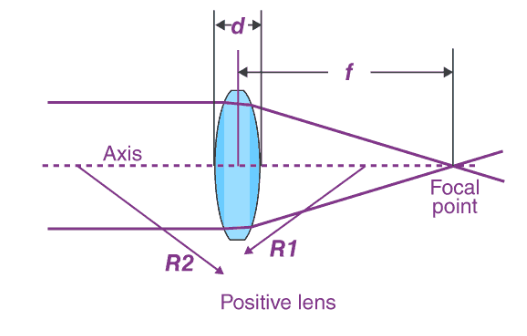Simple lenses include biconvex lenses. It has many uses, including concentrating and regulating laser beams, improving image quality, and employing it in optical instruments.Via the lens, a parallel beam of light converges into a focus or point behind the lens. The positive and converging lenses are other names for the biconvex lens. The focal length of a lens is defined as the distance from the lens to the point behind the lens. There are two curves on either side of the lens, which correspond to two centers and two focus points. The middle of the biconvex lens has a line which is known as the primary axis. Two convex lenses are arranged in a spherical configuration in these symmetrical lenses. The curvature radius is the same for all of these lenses.
Definition
A biconvex lens is a straightforward lens made up of two convex surfaces arranged in a sphere, typically with the same kind of radius of curvature. These lenses are also known as convex-convex ones.
The best example of a biconvex lens is the lens of the human eye. When an eye is looking at nearby objects, the light rays from those items must bend more sharply in order to focus on the retina; in contrast, light rays from distant objects require less refraction. This must be obtained, and it must be of a very elastic form so that the shape can be changed and made either less convex or more convex. The amount of refraction increases with convex lens height.
Mathematical Formula
We are aware that the Lens formula is:
We are aware that the following generic equation describes refraction on a spherical surface:
Considering the illustration used to illustrate the biconvex lens formula now:

The image is created following the initial refraction. Hence, the equation is:
The image is produced following the second refraction. Thus, the following is the equation for the light beam that travels from medium to the medium is:
With (a) and (b) added, we get:
and are equal to the light beams coming from the object at infinity and is the point where the image is formed i.e., ai focus.
Hence, the biconvex lens formula is as follows:
Here, is the radius of the first lens, and is the radius of the second lens.
Properties
The following are some characteristics of a biconvex lens:
- Positive focal length is stated to be a property of biconvex lenses.
- It is stated that their focus lengths are shorter.
- The incident light can be converged by them.
- They possess the capacity to create both physical and virtual images.
- With a conjugate ratio equal to unity, they can erase the coma and distortion in addition to minimize spherical aberration.
- With identical radii on both sides, biconvex lenses are known to be symmetrical in form.
- They are typically advised for a positive conjugate ratio ranging from 0.2 to 5, as well as for the purpose of virtual imaging in the case of genuine objects.
Applications
There are a variety of uses for these lenses, some of which are described below:
- Biconvex lenses are employed as condensing or magnifying devices.
- They can also be used as magnifiers or objectives.
- Many imaging systems, including telescopes, monoculars, microscopes, binoculars, cameras, projectors, etc., use these.
- They are used to create a real image for photographic films or optical sensors or a virtual image for human eyes.
- Moreover, these lenses are employed as burning glass.
- They are employed in a number of different industries as well as in image relay applications.
Hence, a biconvex lens is among the best lenses that may be employed when a light beam incident on a lens is divergent in nature and the beam leaving the lenses converges symmetrically.
Recommended Articles:
Beer-Lambert Law: History, Expression, Derivation and Conditions
Read All About Behaviour Of Gas Molecules
Bell’s Theorem: Definition, Formula, Inequality, Realism, and Theorem
Beta Decay: Introduction, Types, and Theory
Betatron: Definition, Work, Oscillation, Applications and Limitations
Eye The two applications of biconvex lens are mentioned below: The following are some characteristics of a biconvex lens: Biconvex Lens FAQs
Give one example of biconvex lens
Enlist any two applications of biconvex lens.
Biconvex lenses are employed as condensing or magnifying devices.
They can also be used as magnifiers or objectives.Enlist a few properties of biconvex lenses.
Positive focal length is stated to be a property of biconvex lenses.
It is stated that their focus lengths are shorter.
The incident light can be converged by them.
